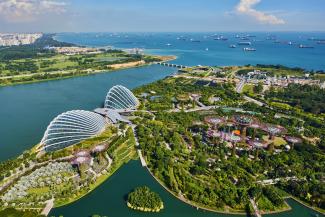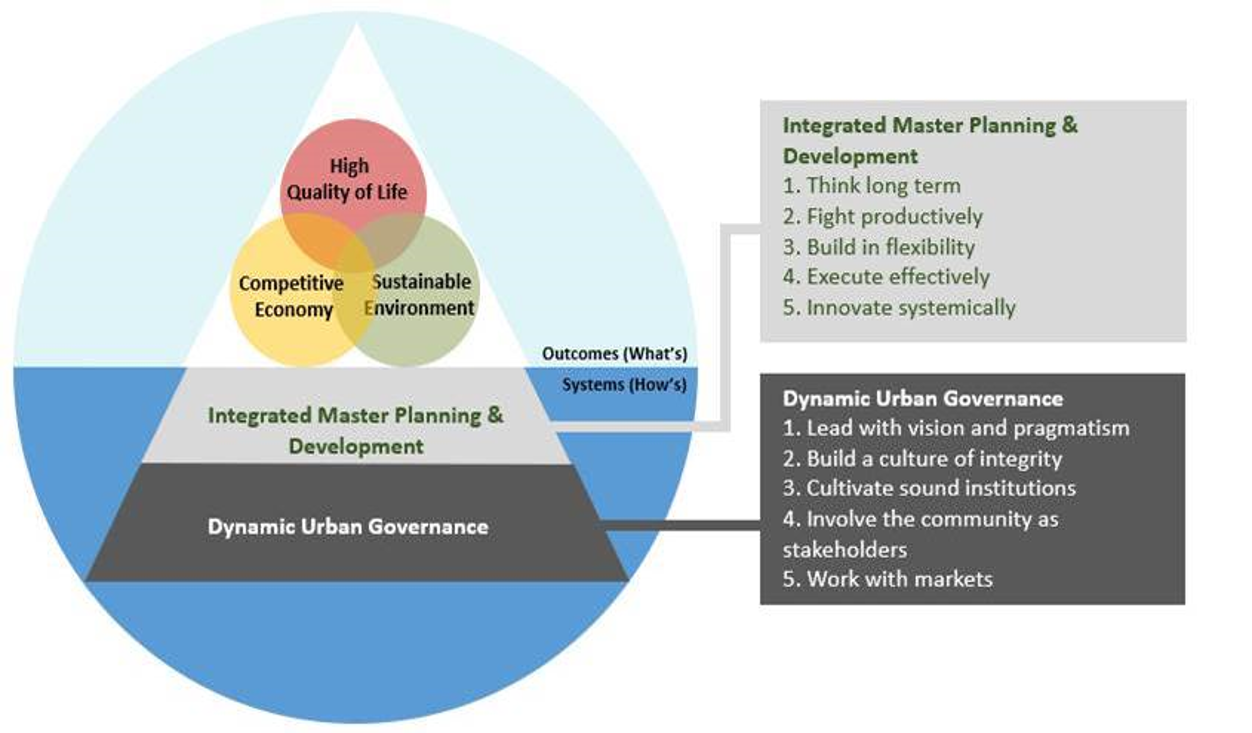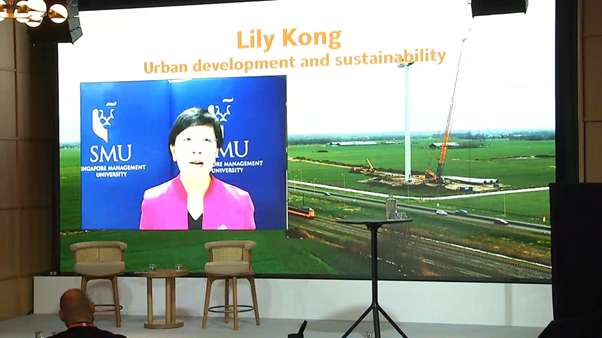
Themed “Recovery – learnings from the pandemic and a sustainable way forward”, this is the 25th year where Swedbank Summit brings together CEOs, Chairmen and owners from the largest corporations and institutions in Sweden, Norway, Finland, Estonia, Lithuania and Latvia. Held in Stockholm, Sweden, some 100 participants gathered for two days to listen to and engage with world class speakers sharing thought leadership on various topics.
Professor Lily Kong, President, Singapore Management University and Lee Kong Chain Chair Professor of Social Sciences was invited to give a virtual keynote address on “Singapore – The making of a sustainable city-state” at the Summit on 22 November.
Prof Kong, who is also Deputy Chair of the Singapore Housing and Development Board (HDB), shared how Singapore is a “City-state-island” and has unique conditions for planning. This is a challenge as well as a blessing – Singapore has only one layer of government and no rural-urban divide. However, it has big neighbours very close by, with different growth trajectories, government priorities, policies, and practices.
Sustainable Singapore
Prof Kong highlighted how, in this neighbourhood context, Singapore can be seen as a wealthy city state amidst a Southeast Asian sea of developing countries. It is sometimes associated with a city of “Crazy Rich Asians”; a city of iconic architectures; and designed for economic sustainability.
It is also a “garden city” from its early days of establishment, when founding Prime Minister Lee Kuan Yew led the charge of tree planting around the city. Today, Singapore has evolved into the notion of a “city within a garden”, and is committed to a biophilic, green and blue environment. Given this, some would argue that there is a strong sense of commitment to environmental sustainability alongside economic sustainability.
Once seen as a culturally impoverished city, dominated by demolition of the old and construction of a new, soulless city, now, Singapore is attentive to heritage conservation and preservation and thus might be said to be paying more attention to the cultural sustainability of the city.
Besides economic, environmental, and cultural sustainability, the city-state has focused on multiple dimensions of social sustainability as well. One key element is the ability to transform from a city of slums and squatters with dirty rivers before the 1970s to one where 80% of the population live in affordable and subsidised public housing . Singapore is also a multicultural population living cheek by jowl and efforts have been put into creating a harmonious and socially sustainable society.
Centre for Liveable Cities – Liveability Framework
Given its very small size, planning is key in Singapore’s urban development. Some might even say Singapore is ‘hyper planned’ – with very little left to fate and chance. Prof Kong introduced the audience to a “liveability” framework that had been developed by the Centre for Liveable Cities (CLC) in Singapore. The framework suggests that, to achieve the desired outcomes of urban planning, viz, ensuring a high quality of life, maintaining a competitive economy, and a sustainable environment, an integrated master planning and development, and a dynamic urban governance was necessary.
Integrated Master Planning and Development
Prof Kong elaborated on each of the five dimensions/features of the integrated master planning and development and how it has aided in Singapore’s growth. Drawing from examples of Singapore’s Land Acquisition Act and land reclamation, the development of science and technology research and innovation hub, One-North, the building of the Mass Rapid Transport system, and the support for the construction industry, Prof Kong emphasized several points: the need to think long term, the willingness to be flexible where flexibility matters, and the need to execute well.
Prof Kong highlighted how "We can all have a vision but if not well executed, nothing will be achieved. And this very attention to execution and detail was a key part of Singapore’s success over the decades”.
Similarly, she emphasized, through the examples, the importance of innovation. “Innovating systematically may sound like an oxymoron, as one thinks of creative, ad hoc and messy ways of doing things. But innovating systematically is a key feature of Singapore’s approach”, added Prof Kong.
Dynamic Urban Governance
Just as integrated master planning has been critical for the small city-island-state, so too has dynamic urban governance been pivotal. Prof Kong highlighted five dimensions of dynamic urban governance – to lead with vision and pragmatism; build a culture of integrity; cultivate sound institutions; involve community as stakeholders; and work with markets.
She spoke on how the government had led with a strong vision and pragmatism to “just do it” in order to house some 200,000 people in newly independent Singapore.
There was a strong message against corruption in Singapore and civil servants were subjected to close monitoring and would be dismissed if they were found to have been corrupt in any way. Among the different government agencies, there was a clear sense of roles, and all were committed to freedom from corruption. Prof Kong added that the clear separation of functions in various Ministries also avoided an abuse of power by its statutory boards and institutions reporting to it.
Turning to the issue of community engagement, Prof Kong highlighted how, for a long time, there has been criticism that planning is top down, and consultation does not take place, or take place sufficiently. Prof Kong acknowledged that Singapore has not always done well in this area and is still learning. She cited two recent contrasting examples where HDB wanted to build housing where two forests used to be – the Tengah Forest Town project and the Dover Forest project. In the former, HDB had said that it was an area of low conservation value and had selectively shared their report. There was much controversy, and there were calls to set aside more land for wildlife. Despite the pushback, little changed and the estate is being built now.
On the other hand, the Dover Forest project fared much better in terms of community involvement. The scientific community, nature enthusiasts, community residents, general public rallied with a petition and this time, HDB learned to work together with the scientific community to undertake studies, involved nature enthusiasts in their studies, and flagged the conservation value of the site. A full environmental report was made available to the public and finally a decision was made to only build on a smaller part of the forest in the medium term.
Lastly, the Singapore government’s role here is to incentivize and support the market to work towards common goals and it has done well to support efforts to develop the local construction workforce through various schemes such as incentivizing local contractors to improve their skill sets, productivity and general workmanship; and for developers and building owners to contribute to the construction of underground pedestrian links in the Central Area.
Sustainable Environment, Competitive Economy and High Quality of Life
In the final analysis, Prof Kong concluded the talk by posing the question of whether Singapore has achieved the desired outcomes of a high quality of life, maintaining a competitive economy and achieving a sustainable environment. The balance between economic, environmental, social, and cultural sustainability continues to be a delicate balance that needs to be struck, and it is not an easy one for an island that is a city that is a country at the same time.
In this regard, the approach of careful planning is necessary, while striking another balance – between organic and organised development.
The talk has been very well-received and was one of the highlights of the two-day summit.

